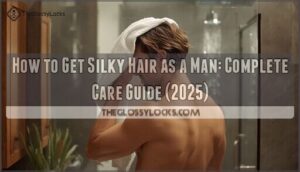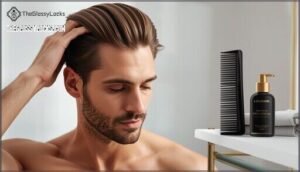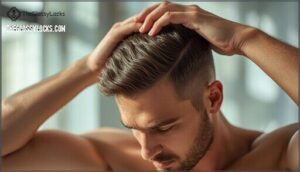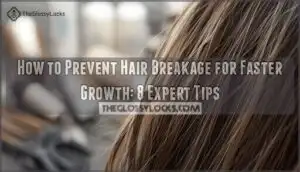This site is supported by our readers. We may earn a commission, at no cost to you, if you purchase through links.
 Most men don’t realize their hair care routine is sabotaging the silky texture they’re after. You might be washing too often, rubbing your hair dry with a regular towel, or skipping conditioner because it seems like extra work. These small mistakes add up to rough, dull hair that never feels quite right.
Most men don’t realize their hair care routine is sabotaging the silky texture they’re after. You might be washing too often, rubbing your hair dry with a regular towel, or skipping conditioner because it seems like extra work. These small mistakes add up to rough, dull hair that never feels quite right.
The good news? Learning how to get silky hair as a man doesn’t require expensive salon treatments or complicated routines. A few strategic changes to your washing technique, product choices, and daily habits can transform your hair’s texture in weeks. The key is understanding what actually damages your hair and replacing those habits with practices that protect and nourish each strand.
Table Of Contents
- Key Takeaways
- How to Wash Hair for Silkiness
- Conditioning and Hydrating Techniques
- Best Hair Oils and Serums for Men
- Styling Tips for Smooth, Silky Hair
- Daily Habits to Prevent Hair Damage
- Nutrition and Lifestyle for Healthy Hair
- Frequently Asked Questions (FAQs)
- How do I get silky hair if I’m a guy?
- How do men get silky and smooth hair?
- How to get silky hair?
- Can a guy have silky hair?
- How can men maintain silky hair?
- How can I make my hair soft & silky?
- What are the best vitamins and minerals to take for hair health?
- How often should I shampoo my hair?
- How can I reduce split ends?
- How do I protect my hair from sun damage?
- Conclusion
Key Takeaways
- Your hair care routine likely causes damage through overwashing, rough towel drying, and skipping conditioner—simple swaps like sulfate-free shampoo, microfiber towels, and regular conditioning can transform texture in weeks.
- Heat styling and environmental factors strip hair strength by up to 40%, so limit tool usage to once weekly, always use heat protectant, and protect hair from UV rays and pollution with hats or UV-filter sprays.
- Natural oils like coconut and Moroccan oil penetrate the hair shaft to reduce breakage by over 40% and boost shine by 35% when applied to damp hair from mid-length to ends 2-3 times weekly.
- Internal health matters as much as external care—aim for 1-1.2g protein per kg body weight, 250-500mg omega-3s daily, and consistent hydration since water makes up 25% of each hair strand and supports nutrient delivery to follicles.
How to Wash Hair for Silkiness
Getting silky hair starts with how you wash it. The right approach protects your hair’s natural moisture while keeping it clean and healthy.
Here’s what you need to focus on to make every wash count.
Choosing Gentle, Sulfate-Free Shampoos
For hair care for men, your shampoo choice makes all the difference. Sulfates can strip natural oils and cause scalp irritation, which is why the market for gentler options is booming. The sulfate-free shampoo market is projected to reach $8.17 billion by 2030.
Here’s what to look for in a gentle shampoo:
- Sulfate-free formulas – These use milder sulfate alternatives that cleanse without damaging hair health
- Natural ingredients – Think Moroccan oil, coconut oil, and botanical extracts
- Ingredient transparency – Check labels for artificial colors and fragrances that dry out hair
- Dermatologist-recommended brands – Male preferences increasingly lean toward expert-backed products
Ideal Washing Frequency for Men
Once you’ve picked the right shampoo, you need to figure out how often to use it. A 2021 study found that washing five to six times per week improved scalp health, reducing flaking and itching.
For hair care for men, your ideal hair washing frequency depends on your hair type and scalp sebum levels. If you’ve got oily hair, wash every one to two days. Dry or curly hair does better with four to five washes weekly. Climate considerations matter too—humid weather or high activity levels mean you’ll want to shampoo more often.
Those with dermatological conditions like dandruff should wash at least three to four times weekly to maintain scalp health. Using the right shampoo is also essential for a great routine.
Patting Vs. Rubbing Hair Dry
After you wash, how you dry your hair matters more than you think. Rubbing vigorously with a cotton towel can increase hair breakage by up to 45% because friction damages the cuticle when it’s vulnerable. Your hair is weakest when wet, so rough drying accelerates brittleness. Instead, gently pat or squeeze water out—this simple shift in your hair drying technique protects against friction hair damage and preserves hair texture.
Best practices for minimizing drying damage:
- Use a microfiber towel instead of cotton to absorb moisture faster with less friction
- Pat or squeeze sections gently rather than rubbing back and forth
- Wrap hair loosely without twisting to avoid putting stress on strands
Microfiber towel benefits are real—studies show they maintain 45% higher hair strength and keep cuticles smoother. This method works for all hair care for men routines, reducing frizz and supporting long-term shine.
Using Cold Water Rinses
One more step can boost your results: finish with cold water. Cold water rinses seal the cuticle, locking in moisture and creating a smoother surface for light reflection—users report up to 90% less frizz and 25% better color longevity over six weeks.
This simple hair washing technique promotes scalp health and enhances hair shine without sacrificing cleansing power. Just rinse cold for the last 30 seconds after conditioning.
Conditioning and Hydrating Techniques
Conditioning is where the magic really happens when you’re going for that silky feel. The right products and techniques can lock in moisture and keep your hair soft without weighing it down.
Here’s what you need to know about conditioners, leave-ins, masks, and ingredients to watch out for.
Selecting The Right Conditioner
Your hair type dictates which conditioner works best. pH-balanced formulas around 5.5 keep cuticles smooth and prevent frizz, while sulfate-free options preserve natural oils and reduce dryness by nearly 40%.
Match your conditioner to your targeted concerns—whether that’s moisture, strength, or thickness.
- For textured hair: Choose conditioners with shea butter or coconut oil for deep hydration
- For fine hair: Pick lightweight jojoba or aloe-based formulas that won’t weigh strands down
- For all types: Look for silicone-free ingredient selection to avoid buildup
Benefits of Leave-in Conditioners
Adding a leave-in conditioner to your hair care routine delivers real results. These products lock in hair hydration for up to 72 hours and cut breakage by nearly half. You’ll see strength improvement within four weeks and frizz reduction of up to 60% in humid conditions.
| Benefit | What You Get |
|---|---|
| Damage Protection | Shields from heat styling and UV rays |
| Hair Softness | Smoother texture with better manageability |
| Styling Benefits | Easier detangling and natural shine |
Leave-in conditioner works because it penetrates your hair shaft, boosting elasticity while protecting against daily wear.
Applying Hair Masks for Extra Softness
When hair masks enter your hair care routine, you’re giving yourself a deep-treatment advantage. These products target hair hydration and softness more intensely than daily conditioners—the market expects to hit $991.9 million by 2030, reflecting rising demand for hair treatment options.
Apply your mask once weekly following these application techniques:
- Focus mid-length to ends on towel-dried hair for better absorption
- Leave in for 10–20 minutes to let proteins and oils penetrate
- Choose mask ingredients like coconut oil, keratin, or avocado for sealing cuticles
- Rinse thoroughly to prevent residue that compromises hair softness
DIY recipes using eggs or honey work well if you prefer natural options.
Avoiding Artificial Colors and Fragrances
Synthetic fragrances and dyes in hair care for men trigger scalp irritation in up to 34% of users—that’s why natural alternatives matter. If you have chemical sensitivities, skip products listing limonene or CI numbers on product labeling. Natural ingredients like aloe or chamomile deliver conditioning without environmental impact linked to petroleum-based compounds. Fragrance-free, color-free hair products reduce irritation by 40% while supporting cleaner waterways.
| Ingredient to Avoid | Why Skip It |
|---|---|
| Artificial fragrances | Cause dermatitis, disrupt skin barrier |
| Synthetic dyes (CI codes) | Linked to allergic reactions, toxicity |
| Limonene, linalool | Top allergens in hair styling products for men |
| Coal-tar derivatives | Generate harmful oxidation byproducts |
| Petroleum-based colorants | High carbon footprint, aquatic toxicity |
Best Hair Oils and Serums for Men
For adding shine and softness, the right oil or serum can make all the difference. Natural oils like Moroccan and coconut work wonders, while lightweight serums give you that polished look without the grease.
Here’s what you need to know about picking and using the best products for silky hair.
Using Moroccan Oil and Coconut Oil
Regarding hair care for men, coconut oil and Moroccan oil are standout choices for achieving silky smooth hair. Coconut oil’s composition—rich in lauric acid—penetrates deep into the hair shaft, boosting hydration effects and reducing breakage by over 40%.
Moroccan oil offers protective properties with its antioxidant-rich formula, improving shine by 35% while smoothing hair texture. Both oils support safe usage with minimal side effects, making hair oiling a reliable hair oil treatment for lasting softness.
How to Apply Hair Oil for Maximum Effect
Getting oil application timing right makes all the difference. Start with damp, clean hair—absorption increases by up to 35% compared to unwashed strands. Use 2–3 drops for medium-length hair, warming it between your palms first.
Apply from mid-length to ends, then gently massage your scalp for 5–10 minutes to boost penetration and blood flow.
This hair oil treatment works best 2–3 times weekly, left on for 30 minutes to 2 hours before rinsing with lukewarm water and double shampooing to prevent buildup.
Lightweight Serums for Shine and Moisture
If oils feel heavy, lightweight serums deliver shine and moisture without weighing you down. These formulas absorb 25–30% faster than traditional products, thanks to ingredients like argan oil, coconut oil, and hyaluronic acid.
Apply a few drops to damp hair—mid-lengths to ends—and you’ll lock in hydration for up to 72 hours while keeping frizz at bay, even in humid weather.
Styling Tips for Smooth, Silky Hair
Getting silky hair isn’t just about the right products—it’s also about how you style it. Heat tools and styling techniques can make or break your progress, so knowing how to work with your hair matters.
Let’s look at two key ways to keep things smooth while you style.
Using Heat Protection Before Styling
Before you reach for styling tools, apply a heat protectant to shield your hair from damage. These products form a protective film that slows heat transfer and keeps your hair strong—treated strands retain up to 90% of their original strength compared to just 60% for unprotected hair.
Spray evenly on damp or dry hair, wait 2–3 minutes for it to set, then style. Look for silicone-based formulas rated for 230°C or higher for best results.
Limiting Heat Styling Tool Usage
Heat damage prevention starts with using your tools less often. Daily flat ironing or blow-drying adds up fast—microscopic cracks, brittleness, and up to 40% weaker strands over time. Aim for once a week or less to let your hair recover naturally.
Keep safe temperature settings below 175°C for fine hair and under 210°C for coarse types. Chemical treatments make things worse—dyed or bleached hair shows 70% more damage at high heat.
Between sessions, try air-drying or cool settings to cut moisture loss by 30% and keep your hair strong.
Daily Habits to Prevent Hair Damage
Getting silky hair isn’t just about what you do in the shower—it’s about what you do every day. Small habits make a big difference in keeping your hair smooth and healthy.
Here are four daily practices that’ll protect your hair from damage and help you maintain that soft, silky texture you’re after.
Regular Trims to Avoid Split Ends
You can’t grow silky hair if you’re constantly breaking it off. Regular trims prevent split ends from traveling up the hair shaft, which causes hair breakage and makes growth retention almost impossible. Here’s how trim frequency aids hair health:
- Get haircuts every 6–8 weeks to remove damaged ends before they worsen—men using heat tools or chemical treatments should trim every 4–6 weeks for better damage prevention.
- Shorter styles need trims every 3–4 weeks to maintain shape and eliminate weakened ends that compromise hair care for men.
- Pair complementary practices like penetrating oils between trims to reduce split-end formation and extend your trim benefits by reinforcing strand integrity.
Sleeping on Silk or Satin Pillowcases
While you sleep, friction from cotton pillowcases creates hair breakage and frizz you don’t need. Switching to a silk pillowcase reduces friction by up to 43%, keeping your hair smoother and healthier overnight. Silk also retains moisture better than cotton—absorbing less than 15% compared to over 40%—so your strands stay hydrated.
Here’s how silk pillowcase benefits compare:
| Benefit | Silk Pillowcase | Cotton Pillowcase |
|---|---|---|
| Friction Reduction | Up to 43% less friction | High friction causes tangling |
| Moisture Retention | Retains 85%+ hair moisture | Absorbs 40%+ hair moisture |
| Hair Breakage | Noticeably reduced breakage | Increases breakage and split ends |
| Skin Health | 43% fewer sleep creases | Creates wrinkles and irritation |
| Allergen Presence | 36% lower allergen retention | Harbors dust mites and bacteria |
Satin alternatives work if budget matters, though they don’t match silk’s moisture retention or natural protein structure for silky hair. For men serious about hair care, this simple swap protects hair health while you rest.
Protecting Hair From Sun and Pollution
UV radiation and pollution effects degrade keratin and strip your hair of natural strength—studies show sun exposure alone cuts tensile strength by over 14%. Prevent damage with UV-filter sprays containing antioxidants like vitamin E for keratin protection. Wear hats outdoors and rinse hair after exposure to pollutants.
Hydration support through leave-in conditioners replenishes moisture, keeping your hair care for men routine effective against environmental stressors causing hair damage and dullness.
Using Microfiber Towels for Drying
Unlike cotton, microfiber towels absorb seven times their weight in water, cutting hair drying time by half while delivering frizz reduction and breakage prevention. Their smooth fibers create less friction—reducing static by up to 40%—and preserve natural oils for lasting silkiness in your hair care for men routine.
- Absorbency efficiency: Dense fibers remove moisture 50% faster than cotton
- Ideal drying: Pat gently for 10–15 minutes on fine hair, 20–30 for thick
- Breakage prevention: 50% less tensile stress protects wet, vulnerable strands
- Frizz reduction: Smooth texture minimizes cuticle lifting and static buildup
- Hygiene benefits: Quick-drying fabric reduces bacterial growth by over 90%
Nutrition and Lifestyle for Healthy Hair
Getting silky hair isn’t just about what you put on it—it starts with what you put in your body. Your diet and daily habits play a bigger role than most guys realize for hair health.
Let’s break down the nutrients and routines that’ll help you build stronger, shinier hair from the inside out.
Key Vitamins and Minerals for Hair Health
Your hair needs the right fuel to stay strong and smooth. Vitamin D promotes hair follicle growth, while biotin benefits include producing keratin for thicker strands. Iron deficiency can cause shedding, so aim for 8–18 mg daily depending on your age.
Zinc supplementation helps, but don’t overdo it—too much can backfire. Hair vitamins like B12 deliver oxygen to follicles, boosting hair growth and health. Watch out for selenium toxicity from excess intake.
These hair nutrients work together to improve hair health and nutrition from the inside out.
Importance of Protein and Omega-3s
Your hair is basically built from protein—95% keratin, to be exact. Protein deficiency weakens strands and triggers shedding, while omega-3 benefits include better scalp circulation and follicular function. Together, they power keratin synthesis and support ideal intake for hair health and nutrition.
- Aim for 1–1.2 g protein per kg of body weight daily from eggs, fish, or legumes
- Get 250–500 mg omega-3s (EPA + DHA) from fatty fish or hair supplements
- Protein-rich healthy diet reduces breakage by 30–40% compared to low-protein intake
- Omega-3s boost hair density and diameter by 20–25% in six months
- Combined, these hair nutrients and hair vitamins improve thickness and reduce shedding within 6–9 months
Staying Hydrated for Hair Moisture
Drinking enough water isn’t optional—it makes up 25% of every hair strand. Dehydration effects show up fast: brittle strands, breakage, and a dry scalp that slows growth.
Staying hydrated keeps hair moisture locked in, aids scalp hydration, and helps nutrients reach your follicles.
Environmental factors like indoor heating can drop hair hydration by 30%, so aim for consistent water intake daily to counter hair dryness and maintain hair health.
Adopting Consistent Healthy Hair Routines
Water keeps your hair hydrated—but routine impact matters just as much. Habit stacking simple steps makes your hair care routine for men sustainable. Consistent grooming improves scalp health, boosts softness by 23%, and cuts breakage by 28%.
Five essentials for your haircare routine:
- Wash 2-3 times weekly for ideal scalp health
- Condition every wash to lock in moisture
- Apply hair oil while damp for deep hydration
- Sleep on silk pillowcases to reduce friction
- Schedule trims every 6-8 weeks to prevent splits
Routine personalization beats product cycling—stick with what works for your hair grooming needs.
Frequently Asked Questions (FAQs)
How do I get silky hair if I’m a guy?
You want soft, smooth strands that catch light instead of looking rough and lifeless. The secret lies in proper male hair texture care—gentle shampoos protect scalp health, while oils and serums boost shine.
Combine smart product ingredient analysis with heat protection and consistent routines to transform your hair styling approach. Environmental damage control matters too.
How do men get silky and smooth hair?
Getting smooth hair starts with understanding your hair texture types and genetic hair factors.
Use sulfate-free shampoos with quality ingredients, condition regularly, and apply lightweight hair oils like argan or coconut to damp hair for moisture and shine.
How to get silky hair?
You need three things: the right products, gentle handling, and consistent care.
Focus on sulfate-free shampoos, leave-in conditioners, and hair oils like coconut or argan oil to boost shine and reduce frizz while improving texture and manageability naturally.
Can a guy have silky hair?
Yes, any guy can achieve silky hair with proper care. Genetic factors and androgen levels influence hair texture naturally, but cuticle health and sebaceous oils play huge roles too.
Consistent hair care for men—using gentle products and nourishing treatments—helps you reach your hair health goals, regardless of your starting point.
How can men maintain silky hair?
Maintaining hair health involves consistent scalp health care, choosing products with clean ingredients suited to your hair porosity, addressing water hardness if needed, and embracing lifestyle impact through proper hair care routines that support achieving silky smooth hair for men long-term.
How can I make my hair soft & silky?
Think of hair like fabric—rough handling ruins silk fast.
You’ll get silky hair by using sulfate-free shampoos, conditioning regularly, applying natural oils like coconut or argan, and limiting heat styling.
Additionally, eating protein and omega-3s and staying hydrated contribute to lasting hair health.
What are the best vitamins and minerals to take for hair health?
Your hair needs biotin benefits for keratin production, iron deficiency correction to prevent hair loss, zinc intake for follicle strength, vitamin D for healthy hair growth cycles, and vitamin E to reduce oxidative stress—all supporting hair health and nourishment through a healthy diet.
How often should I shampoo my hair?
Shampooing every 2–3 days strikes the sweet spot for most men, balancing natural oils with cleanliness. If your scalp’s oily or you exercise daily, wash more often.
Dry hair types? Once or twice weekly works wonders, preventing post-wash dryness and product buildup.
How can I reduce split ends?
Split ends happen when heat styling, chemical treatments, and mechanical stress damage hair cuticles.
Get regular trims every 8-12 weeks to stop hair breakage from traveling up the shaft. Seal ends with natural oils, use heat protection, and handle your hair gently to prevent further damage.
How do I protect my hair from sun damage?
Just like your skin, your hair faces constant assault from UV radiation effects. Wear wide-brimmed hats or caps as physical barrier options—they block up to 98% of harmful rays. Use products with UV filters to shield against hair damage and lipid oxidation.
Melanin’s role provides some natural protection, but you’ll still need extra defense against hair and sun damage.
Conclusion
Getting silky hair isn’t about flawlessness—it’s about giving your hair what it actually needs instead of what you assume it wants. You’ve learned how to get silky hair as a man through smarter washing, proper conditioning, and protective habits that work with your lifestyle.
Start with one or two changes this week: switch your towel, add a conditioner, or trim those split ends. Your hair won’t transform overnight, but stick with these practices and you’ll notice the difference within a month. That smooth, healthy texture you’re after is closer than you think.
- https://www.saltgrooming.com/blogs/blog/how-to-get-softer-hair-for-men
- https://1821manmade.com/blogs/behind-the-barrel/how-often-should-a-man-shampoo-his-hair
- https://us.jshealthvitamins.com/blogs/browse/a-hair-health-guide-for-men
- https://timesofindia.indiatimes.com/life-style/beauty/how-heat-styling-and-festive-hairdos-can-impact-hair-health-and-ways-to-mitigate-damage/articleshow/114391250.cms
- https://mcpress.mayoclinic.org/living-well/looking-to-improve-your-hair-and-scalp-health-know-the-ingredients-to-avoid-in-shampoos/












